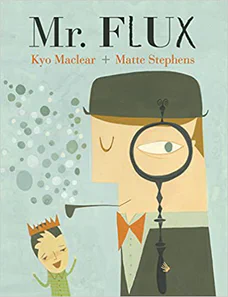Mr. Flux

Recommended Age Range: Kindergarten through 4th grade.
Publisher's Summary:
Martin and his neighbors eschew change until eccentric Mr. Flux moves in and shows them that change can be big or little or even fit inside a box, and not at all scary. A tongue-in-cheek tale loosely inspired by the 1960s art movement known as Fluxus.

Dr. Annie's Takeaways
Recommended for: This book is a very fun and very wise story about learning to live with change, and sometimes even liking it. It’s wonderful for kids who are nervous about change, as well as kids whose uniqueness is sometimes criticized by others who prefer things to stay the same. It introduces the idea of experimenting with small changes as a means of building up to bigger changes, which is a great set-up for talking about change-related exposure therapy
.
Would a child like it? Children who are a bit nervous about change will immediately relate to Martin and be delighted by his and his town’s transformation. It’s also a wacky and very fun story.
Evidence-Based Practices:
Exposure
Tone: Quirky, dry-humored
Story Quality: This is a story both for children and for adults. I loved it. It’s about change and zany art, and it’s a well-written, captivating story that holds an important message. It has some great lines, such as this awesome start: “There once was a boy named Martin who didn’t like change. Actually, it wasn’t that he didn’t like change, but more that he didn’t know change.” And this ending line, “Sometimes change is big, and sometimes it’s small, and sometimes change is just change, and that’s fine too.”
Illustrations: Quirky, fantastical illustrations that are well-matched to the story’s tone.
Representation: Martin is a White boy with a White mother. Mr. Flux is a White man. They live in a town populated by White people living in nearly identical suburban houses– “It was a very nice, but predictable place.”
Psychological Practices: By introducing Martin to small changes and then bigger ones, Mr. Flux helps Martin realize that change is ever-present (“What stays the same?”) and not something he needs to fear. At first, Martin and the people in his town are suspicious of all changes: “Change is upsetting, and we like things just the way they are.” Change, Martin suspects, contains “cacophony, disorder, and germs.” Mr. Flux moves in like a zany Mary Poppins to teach the town that change can be good. He shows Martin his art (a nod to the experimental 1960s Fluxus art movement
, which I learned about through this book), and invites Martin to join him in novel, wacky pursuits like spinning toy rabbits on his record player. This inspires Martin to try more new things on his own, like eating something different for breakfast. Over time, the people in town are inspired to try new things too. They paint their houses different colors and “children began to wake up early, hoping to spot something new.” By the end of the book, Martin feels ready for bigger changes, and Mr. Flux is ready to move on.
Concerns: Mr. Flux is pictured with a stylized pipe in his mouth (along with a bowler hat and monocle). He’s a caricature of a 1960s gentleman, many of whom did smoke, but I wanted to provide a heads up to families sensitive to images of substance use.
